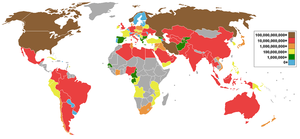- Image via Wikipedia
A new type of natural-gas electric power plant proposed by MIT researchers could provide electricity with zero carbon dioxide emissions to the atmosphere, at costs comparable to or less than conventional natural-gas plants, and even to coal-burning plants. But that can only come about if and when a price is set on the emission of carbon dioxide and other greenhouse gases — a step the U.S. Congress and other governments are considering as a way to halt climate change.
Postdoctoral associate Thomas Adams and Paul I. Barton, the Lammot du Pont Professor of Chemical Engineering, propose a system that uses solid-oxide fuel cells, which produce power from fuel without burning it. The system would not require any new technology, but would rather combine existing components, or ones that are already well under development, in a novel configuration (for which they have applied for a patent). The system would also have the advantage of running on natural gas, a relatively plentiful fuel source — proven global reserves of natural gas are expected to last about 60 years at current consumption rates — that is considered more environmentally friendly than coal or oil. (Present natural-gas power plants produce an average of 1,135 pounds of carbon dioxide for every megawatt-hour of electricity produced — half to one-third the emissions from coal plants, depending on the type of coal.)
Absent any price for carbon emissions, Adams says, when it comes to generating electricity “the cheapest fuel will always be pulverized coal.” But as soon as there is some form of carbon pricing — which attempts to take into account the true price exacted on the environment by greenhouse gas emissions — “ours is the lowest price option,” he says, as long as the pricing is more than about $15 per metric ton of emitted carbon dioxide. Such a pricing mechanism would be put in place, for example, by the Waxman-Markey “American Clean Energy and Security Act” that was passed by the U.S. House of Representatives in July, through its “cap and trade” provisions. (A corresponding bill has not yet reached the floor of the U.S. Senate.) If the program becomes law, the actual price per ton of carbon would vary, being determined through the free market.
Related articles by Zemanta
- The Hidden, $120 Billion Cost of America’s Energy Mix (blogs.wsj.com)
- Greeley, Colorado To Convert Methane From Cattle Manure Into Energy (huffingtonpost.com)
- Natural Gas Hits a Roadblock in New Energy Bill (nytimes.com)
- IMF could fund climate adaptation: Soros (cbc.ca)
- CO2 Solution Receives Power Plant Patent (newswire.ca)
![Reblog this post [with Zemanta]](http://img.zemanta.com/reblog_b.png?x-id=0ab23705-751e-48f5-b4b0-e11bf70bcc81)








